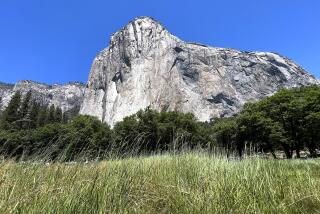Trail Maintenance Long Overdue
- Share via
While the U.S. Forest Service wastes tens of millions of dollars every year building roads into timber-harvest areas that lose the government money, it has allowed the national forest trail system to deteriorate at an alarming rate. Recreation for the public is taking a back seat to the illogical and uneconomic subsidization of private timber companies.
In response to questions from Congress’ General Accounting Office, the Forest Service blames lack of funds over the past decade for a $195-million backlog in needed maintenance and reconstruction of recreational trails totaling nearly 60,000 miles. The inadequate funding has been exacerbated by the loss of experienced employees who have been transferred from trail maintenance to other programs, according to the accounting office.
Actually, the Forest Service, an agency of the U.S. Agriculture Department, did not really know how bad the trail maintenance situation had gotten because it did not even collect such data. The GAO got the information by sending questionnaires to the supervisors of all 121 national forests. In the Pacific Southwest Region, which includes California, about 7,000 miles of trail needed work or reconstruction at an estimated cost of $27.6 million.
In the past two years, Congress has responded to the public’s complaints of deteriorating trail conditions by increasing the Forest Service’s maintenance and construction budget from $20 million in fiscal 1987 to nearly $37 million in fiscal 1989. Without adequate maintenance, the accounting office said, trails become difficult to use, impassable or lost altogether. The forest supervisors told the GAO investigators that about 5,200 miles of trails were impassable or closed because of lack of maintenance. Even in recent years, California members of Congress had to get a special appropriation for work on one of the most famous of all Forest Service routes, the trail to the summit of Mt. Whitney.
Without proper maintenance, erosion and other natural forces accelerate deterioration rapidly. The Forest Service’s priorities are, first, to correct health and safety hazards; second, to minimize natural damage, and third, to restore the trail fully to design standards.
The national forests had 238 million recreational visitor-days of use in 1987, more than twice the level of the national parks and more than 40% of the recreation provided by all federal agencies. The deterioration of the trails must be stopped and reversed. Recreation in the forests must no longer be neglected while the Forest Service continues to subsidize unprofitable timber harvests. Congress should give the Forest Service the money needed to eliminate the backlog and then make sure the job gets done.
More to Read
Sign up for The Wild
We’ll help you find the best places to hike, bike and run, as well as the perfect silent spots for meditation and yoga.
You may occasionally receive promotional content from the Los Angeles Times.






